Viking: Battle for Asgard Review
Viking: Battle for Asgard
Can the blood, guts and epic battles set in a sprawling Norse fantasy world bring out the heroic Viking in Stu?
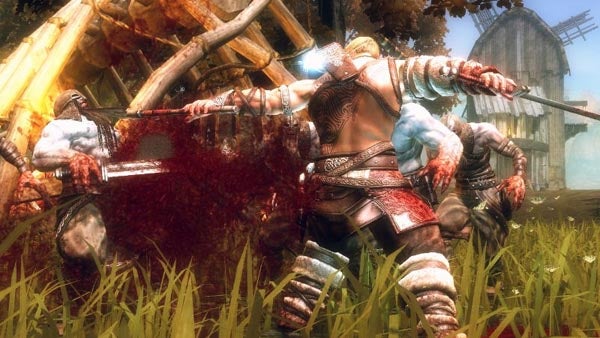
Verdict
Key Specifications
- Review Price: £32.93
”’Platfroms: Xbox 360, Playstation 3. Xbox version reviewed.”’
There’s no question in my mind that Viking: Battle for Asgard is the bloodiest hack-and-slash epic I’ve ever seen, making the horrifically brutal God of War look like The Chronicles of Narnia by comparison. Where most warriors might feel content that an enemy without a head is no longer a threat, Viking’s hero, Skarin, doesn’t stop until both arms have been lopped off and the top half of the torso has been severed from the bottom. All of this comes with an awful lot of claret splashed around, and in gory slow-motion detail when you pull off a particularly vicious combo attack. With a lot of games, I might have suspected that all this ultra-violence was designed to cover a lack of gameplay, but with Viking it just ain’t so. It’s also one of the brainiest hack-and-slash epics I’ve ever seen.
In case you haven’t seen our preview, this Norse fantasy thriller pits Skarin – chosen hero of the goddess Freyja and the gods of Asgard – against the forces of Hel, goddess of the underworld. In practice, this means exploring the three sizable island territories of Midgard, wiping out Hel’s grunts and minions, releasing Viking captives, gathering gold, discovering useful magic items and completing any number of miscellaneous tasks. Release enough Vikings to form an army and complete any other related objectives and you can trigger a huge set-piece battle. Here your guys square up to Hel’s goons, and it’s up to you to turn the tide of battle in their direction by taking out archers, champions or heavy infantry or defeating the shamans responsible for the continual flow of hostile forces.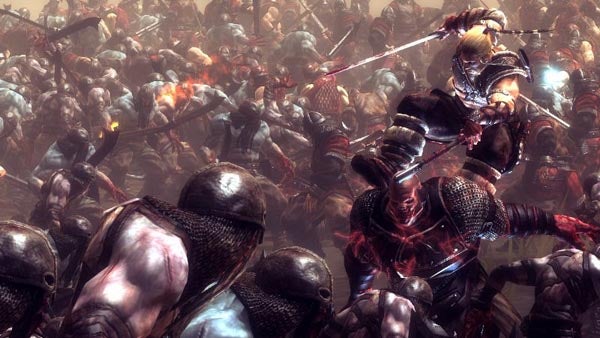
It’s a fairly simple structure, but one that offers you the sort of freedom you don’t usually get in this sort of game. While the available tasks are contingent on what objectives you’ve achieved already – releasing one set of captives may give you a nugget of information that opens up a new mission – you’re free to wander the island doing whatever open task you like. The islands are covered by a network of standing stones that offer instant travel from one section to another, and once the island has loaded once there are no boring loading times to break up the action. As a result, Viking is a surprisingly free-flowing experience and it’s rare to find yourself stuck in a frustrating situation. If you’re finding one objective too tough, you can usually come back to it later when you’re a little more prepared.
And this preparation is where the brains come in. Charge into every fracas and treat Viking like it’s just another hack-and-slash game and you won’t often come out on top. Hel’s troops are frequently too numerous or too tough for you to take on large numbers simultaneously, so it pays to look for an alternative approach. Once you’re a third of the way into the game you’ll find yourself scoping out each enemy encampment with care, looking for possible points to infiltrate and working out whether there’s a way to free the captives without calling out every undead mongrel in hearing distance. Doing so is worthwhile, because once freed your men will happily fight their own way out to safety, tipping the balance of power back in your favour. It’s not that Viking is an easy game – there will be times when you feel like you’re banging your head against a brick wall – but when those times arise it’s usually because you’re taking the wrong approach. Unable to infiltrate Hel’s barracks because the guards and champions are just too tough to take on your tod? Can’t free those prisoners without getting shot down by archers? Don’t just resurrect and transport yourself back to the nearest stone and try again – look for another angle and you should see a new way forward.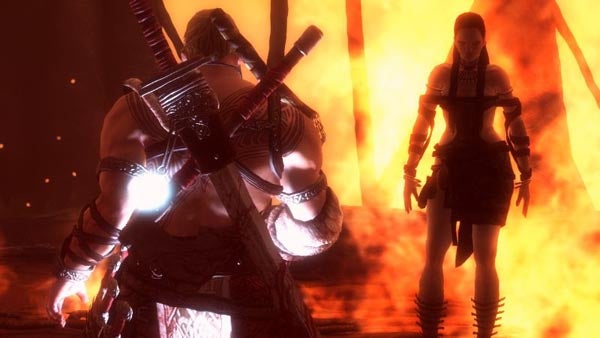
Stealth and exploration are important to the game and there are even a few sections that require sub-Tomb Raider platforming skills. All the same, combat is at its bloody heart. At first the fighting system seems crude and simple, particularly after the likes of God of War 2 or Devil May Cry 4, with only two basic attacks to kick off with. In fact, you can get through a sizable chunk of the game using just these attacks in basic combos, but you’ll have a fairly miserably time of it. Groups of goons will take ages to batter, and you’ll regularly find yourself back at your restart point. The trick is to find each island’s battle arena and then cough up your horded gold for additional moves. These, activated using combinations of the attack buttons and bumpers, will enable you to carve your way through groups of enemies in a shorter time, or tackle the bigger chaps with fewer carefully timed blows. 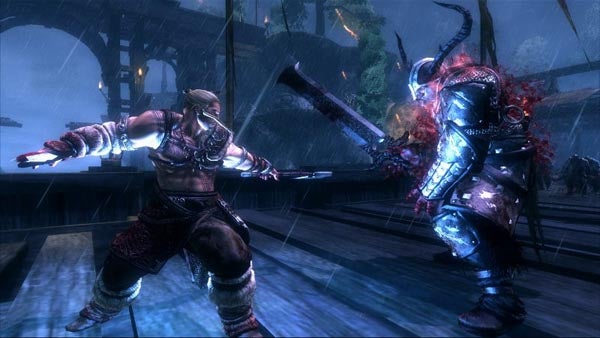
Even once your combo list has begun to fill up the hack-and-slash action never quite hits the heights that it does in GoW2 or DMC4, but it’s certainly capable and very satisfying. On top of that, it’s one of the few games outside of the God of War games to get finishing moves right. Sure, it’s still a case of whacking the right buttons in the right order, but the prompts are large, the timing isn’t split second, and the grisly slow-motion pay off always makes the effort worth your while. Frankly, I’m not 100% sure I want to see blood and guts this detailed, but it all helps to make Viking the highly visceral experience it is.
When the blood’s not flowing it’s also a surprisingly beautiful game. Midgard is one of the finest fantasy worlds we’ve seen on this generation of consoles – packed with the sort of rushing waterfalls, jagged rock and stormy coastal scenery that you’d expect from a Wagnerian epic. The Viking settlements and structures show a real eye for Norse style, and even the gloomy caves and rain-soaked battlefields look impressive. Skarin and his foes, meanwhile, are superbly modelled, lit and animated. At times, Viking looks like the sort of classic fantasy painting that used to adorn book covers in the days before people got embarrassed about reading tales of dragons, magic swords and hulking barbarians and wanted to pretend they were reading something more artsy and sophisticated instead. I think this is a good thing (the artwork, not the change in book cover design) and if the odd moment where the grass pops in in the background is the price you pay, then that’s something I’m willing to live with. I also love the way in which the atmosphere changes depending on whether Skarin has liberated an area from Hel’s control. As Skarin enters a Legion-dominated area, the skies darken and the rain and mist creep in. Once liberated, the sun streams in and the whole world comes to life again. It makes you feel good about crushing skulls and lopping off limbs.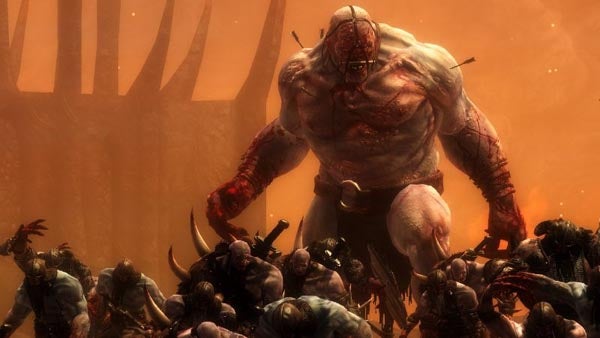
Admittedly, there are times when the world doesn’t feel quite as real as it might. It doesn’t help that your Viking chums and monstrous foes only have a handful of 3D models and textures to go round, nor does it help that very few of them have any personality to speak of. It’s slightly annoying that you can explore an area once and clear out every member of Hel’s legion, then you’re sent back half an hour later on a mission and they’re all back again along with a significant artefact that has – mysteriously – only just appeared. Meanwhile, the landscape isn’t quite as interactive as you might hope. Only a few structures can really be clambered around on, and it’s frustrating to think that you might be able to sneak into an enemy encampment over crates or rooftops, only to find that the game has rather arbitrarily said no. In some ways, Viking feels like a heroic fantasy version of Crackdown, but the great joy of Crackdown was that you knew you could go anywhere if only you had the acrobatic powers to do so. In Viking, you’re more constrained by the game as to where you can go and what you can do. 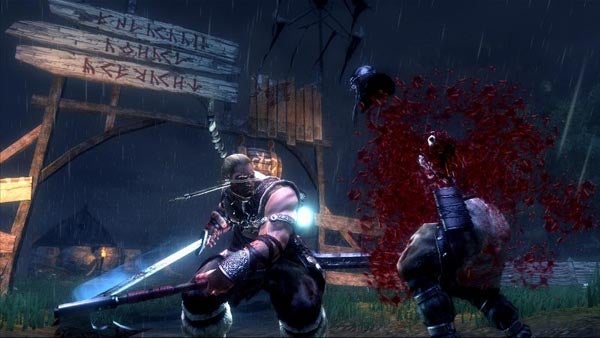
That said, the basic exploration and combat gameplay is never less than entertaining, and the set-pieces – the battles – are almost everything you might have hoped. Each is divided into a series of stages, with the completion of objectives in one stage opening up the next. While your Viking chums charge into the fray, it’s up to you to add support or lead them in the right direction by example, storming in to tackle elite enemy forces or troublesome pockets of resistance, while eliminating shamen or destroying any of Hel’s champions that march your way. Best of all, you’re also tasked with picking targets for your ultimate weapon – the dragons. You’ll need to purchase their services with tokens earned by battling champions or shamen, but once you do you can send them to preset targets which they’ll promptly wipe out in flame-grilled style.
OK. I can think of some reasons to grumble about the battles. At times, the frame rate takes a hit due to the sheer amount of carnage going on on-screen, and there are times when it all gets a bit confusing or when you’d like a bit more control of where your comrades are going and what they’re doing. All the same, I can’t think of another action game that has simulated mass combat this effectively. Vikings and Hel’s legions aren’t just standing in the background and poking each other politely with spears – they’re hacking at each other like their lives depend on it. There’s a real sense of weight and momentum to the fighting, and something undeniably thrilling about being at the spearhead of a headlong Viking charge. We’re not talking of some weedy battle like the one thrown in at the end of the ”Golden Compass” movie; we’re talking Helm’s Deep in Peter Jackson’s ”The Two Towers”. And if the mano-e-mano fights that cap the major confrontations are a little anti-climactic in comparison to the big boss battles in God of War 1 or 2, the overall experience is still bloody great.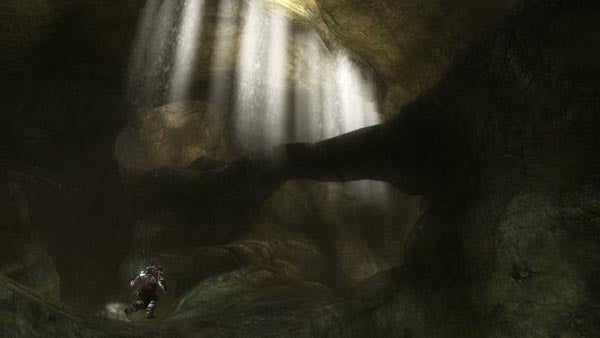
Overall, I’ll admit to a little disappointment with how Viking has turned out, but only a little. Let’s be clear. For all its blood and guts, Viking isn’t as dramatic or magnificent a game as Sony’s mighty Greek myth duo, but then they present a fast-paced, pre-scripted, linear chain of encounters, not a world you can explore as you will. Viking is a bit of a slow burner, and it requires a different kind of play. Arguably its biggest fault is that – even with a clearly marked map and plenty of onscreen help – it doesn’t always make it clear quite what that play is. Were there a sequel (and I genuinely hope there is) it could do with a little more variety on the objectives front, a spot more in the way of interactive scenery and a few more genuinely impressive beasts to slay (I’m sure Norse mythology runs thick with that sort of thing), but this first instalment remains one of the most engaging and immersive games I’ve played so far this year. Have a little patience and prepare for an awful lot of blood, and this is one saga you’ll be happy to see through right to the end. 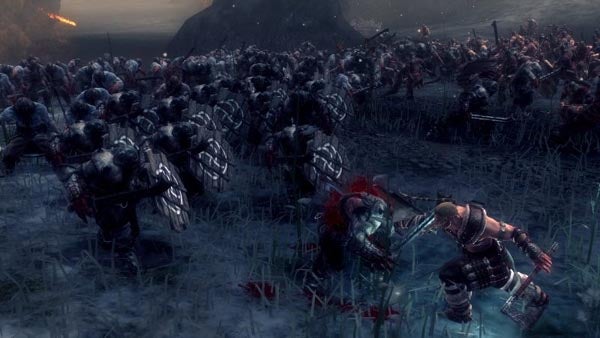
”’Verdict”’
Not quite the God of War/Spartan/Crackdown combo we might have hoped for, but still a fine hack-and-slash epic with impressive battles and a magnificent world to explore.

